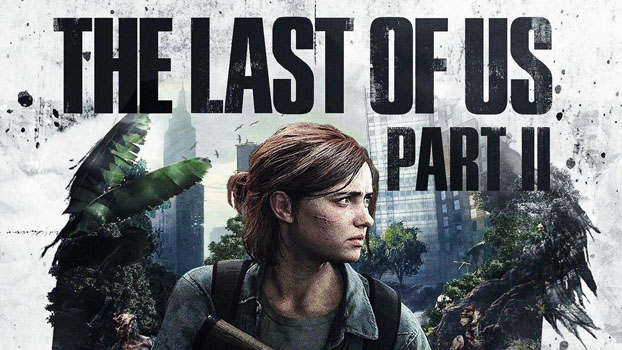It’s been about three weeks since Naughty Dog dropped their nuclear bomb on the gaming world and the fallout still hasn’t settled. I did my best to avoid all the leaks and spoilers and refused to read a single review prior to my own gameplay experience. With no personal, professional, fan, or critic bias I felt pretty objective going into The Last of Us Part II, and just over 30 hours later after finishing the game I find myself wondering what all the fuss was about. Spoilers ahead assuming this game can still be spoiled.
There are two ways to approach a review for The Last of Us Part II. You can treat it as an interactive movie, at which the game excels, or you can attempt to dissect the gameplay from the narrative. The latter proves to be more difficult than you’d think because the hours and hours of amazing cutscenes are just part of the big picture. There are just as many hours of exposition contained in casual conversations between characters and the reams of notes, diaries, and other collectible reading materials scattered about the game. But if we could surgically remove the gameplay from the narrative what would we have?
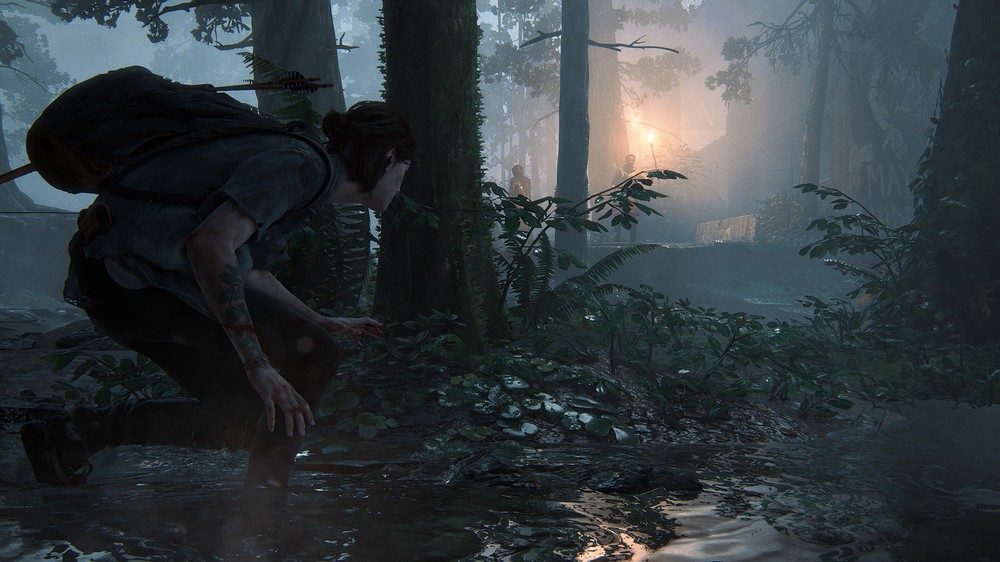 The gameplay loop in The Last of Us Part II is fairly basic and totally repetitive. For some odd reason it appeals to my own OCD nature of meticulous exploration and methodical collection of every item my pack can hold to the point where the word FULL would appear during most of my looting. The game cycles between two types of play; slow laborious exploration with maybe some light puzzle solving like, “how do I get in there?” or finding the combo to a safe to the more exciting stealth and combat sections that are also treated like puzzles, tasking you with enemy prioritization and sneaking around for silent takedowns to thin the enemy ranks or if lucky, stealth-kill them all. When guns finally do come into play you have an impressive and varied arsenal of weapons that can be modified via a workbench crafting system that plays nicely with your own personal crafting of med kits and other useful gadgets that are fueled by all those hours of exploration and collection you’ve been doing.
The gameplay loop in The Last of Us Part II is fairly basic and totally repetitive. For some odd reason it appeals to my own OCD nature of meticulous exploration and methodical collection of every item my pack can hold to the point where the word FULL would appear during most of my looting. The game cycles between two types of play; slow laborious exploration with maybe some light puzzle solving like, “how do I get in there?” or finding the combo to a safe to the more exciting stealth and combat sections that are also treated like puzzles, tasking you with enemy prioritization and sneaking around for silent takedowns to thin the enemy ranks or if lucky, stealth-kill them all. When guns finally do come into play you have an impressive and varied arsenal of weapons that can be modified via a workbench crafting system that plays nicely with your own personal crafting of med kits and other useful gadgets that are fueled by all those hours of exploration and collection you’ve been doing.
The entire game consists of this repetitive back and forth formula of hunting and gathering then using all that stuff to kill a dozen or so enemies in an arena-style encounter then do it all over in another location. And what locations they are. The game picks up a few years after the first one left off with Joel and Ellie in Jackson, WY, an impressive settlement where life has seemingly returned to almost-normal. I won’t go into too much story details, but Ellie has a new romantic interest, Dina, who just shared their first kiss at a party the night before. Ellie and Joel seem to have a strained relationship, and we learn why much later in the game during a flashback where Ellie learns the truth about her visit to the hospital.
 Fans of linear storytelling are going to be disappointed with The Last of Us Part II. The narrative is chopped and scrambled to the point where Pulp Fiction seems linear. If you miss a title card saying 4 Years Earlier or 3 Month Earlier you could be totally lost. There are at least a dozen flashbacks and time shifts in this game all the way to the very end, and I suspect many were to keep Joel a part of the story long after his death.
Fans of linear storytelling are going to be disappointed with The Last of Us Part II. The narrative is chopped and scrambled to the point where Pulp Fiction seems linear. If you miss a title card saying 4 Years Earlier or 3 Month Earlier you could be totally lost. There are at least a dozen flashbacks and time shifts in this game all the way to the very end, and I suspect many were to keep Joel a part of the story long after his death.
So how about that story; the story that has fans and critics divided and threatens to burn the internet to the ground? I enjoyed it. Despite the fact that the writers didn’t seem to know when to quit, I really enjoyed it. I suspect there was some manipulation by the designers to make me feel certain ways at certain times. The first half of the game is a classic revenge saga that has you rooting for Ellie and Dina on their quest to find and kill Abby, and just when you do the game flips the script and has you playing as the “villain” for almost as long as you’ve been playing as the “hero”. Lots of people seem to hate the concept of playing as Abby, but I thought it was a genius design decision that presents both sides of the story.
Keeping in mind that a villain is the hero of their own story, when we view the events of the previous game and the sequel through Abby’s eyes it is quite clear that Joel is clearly the villain of her story and in many ways I found more empathy with Abby than Ellie. Abby certainly had a more interesting character arc that showed more personal growth over her part of the adventure. As a gamer we never got to make that binary decision with Ellie in the previous game. We were forced to doom the human race to having no cure for our own selfish desire to protect our surrogate daughter as well as killing the father of another young girl while doing so. Our view of Joel was tainted by all the manipulative events leading up to that rescue, but when viewed objectively from just about anyone else in the world, Joel was an evil smuggler that deserved to be punished. Was the resulting punishment too severe? I think it was played more for shock value, but we clearly see that even Abby has issues with her actions later in the game driving her to seek her own penance and redemption.
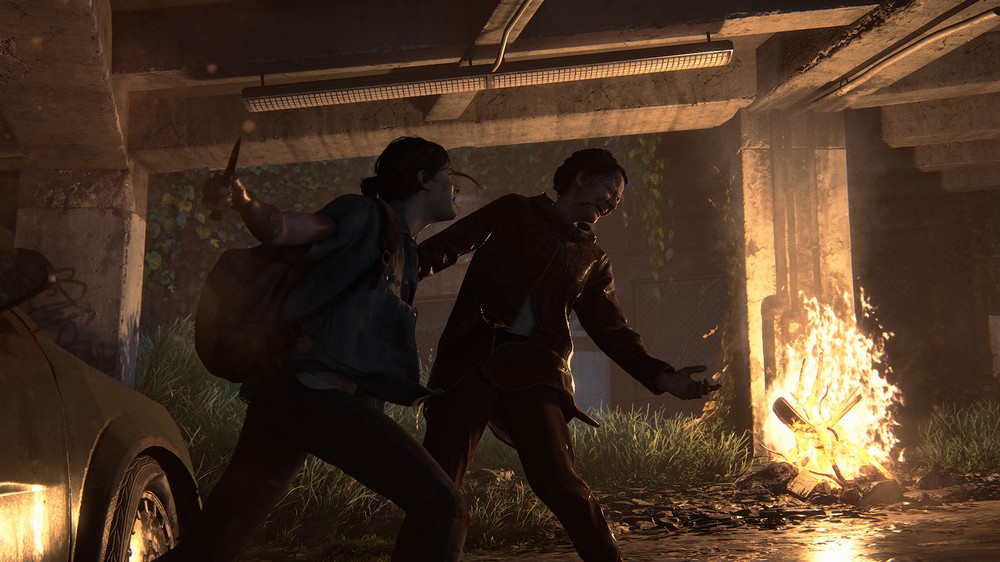 The Last of Us Part II is essentially two games in one. Ellie and Abby each have their own styles of play, their own unique arsenal with fresh upgrade trees and even their own type of gadgets and gear. Ellie’s game was almost too easy at times with an unbreakable knife that offered nearly unlimited silent kill potential while Abby had to use crafted shivs, just like the first game, good for a single kill. This meant that if you got attacked by a Clicker and didn’t have a shiv you were dead. But Abby had her own advantages as well like an awesome crossbow and biceps that could crush a man’s throat in less than five seconds.
The Last of Us Part II is essentially two games in one. Ellie and Abby each have their own styles of play, their own unique arsenal with fresh upgrade trees and even their own type of gadgets and gear. Ellie’s game was almost too easy at times with an unbreakable knife that offered nearly unlimited silent kill potential while Abby had to use crafted shivs, just like the first game, good for a single kill. This meant that if you got attacked by a Clicker and didn’t have a shiv you were dead. But Abby had her own advantages as well like an awesome crossbow and biceps that could crush a man’s throat in less than five seconds.
While the infected play a significant part of the game most of the violence is human on human, or if you’re lucky you can get the infected to work for you and attack your enemies while you stand back to enjoy the chaos. There is nothing more satisfying than torching a guy with a Molotov who instinctively starts to run around and scream attracting all the nearby Clickers. Clickers also have a new trick up their sleeve – echolocation, so even though they are blind they can “see” you if you are facing them when they screech. The only new creature added to the mix is the Shambler that can throw acid bombs at you and explode like a suicide bomber for massive damage. And there are some impressive boss fights; especially the one in the hospital.
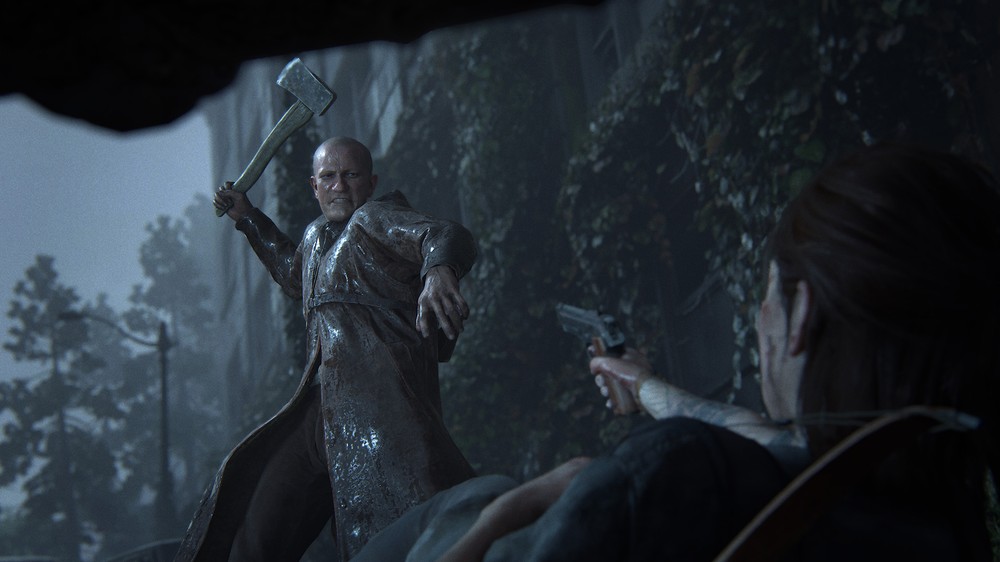 More marathon than sprint, The Last of Us Part II bloats the gameplay with dozens of collectibles; trading cards for Ellie and state coins for Abby. They are fun when you find them but actually forcing yourself to find them is banal busy work that only distracts from the momentum of the adventure. Even with my own OCD I only found about 75% of all the collectibles in the game. I particularly enjoyed playing the second half of the game that overlapped the events from the first half, only now through Abby’s point of view. There were some great moments of realization that played off both halves of the game like hearing about a sniper pinning down some Wolves while playing as Ellie then playing as Abby and finding out you are the one being pinned down.
More marathon than sprint, The Last of Us Part II bloats the gameplay with dozens of collectibles; trading cards for Ellie and state coins for Abby. They are fun when you find them but actually forcing yourself to find them is banal busy work that only distracts from the momentum of the adventure. Even with my own OCD I only found about 75% of all the collectibles in the game. I particularly enjoyed playing the second half of the game that overlapped the events from the first half, only now through Abby’s point of view. There were some great moments of realization that played off both halves of the game like hearing about a sniper pinning down some Wolves while playing as Ellie then playing as Abby and finding out you are the one being pinned down.
The Last of Us Part II felt more like the extended Director’s Cut version. Nothing was left on the editing floor and they might have even thrown in some DLC. There were entire sections of the game that felt tacked on, parts that seemed there only to manipulate the characters and the player’s emotions. I quite literally thought I was playing an epilogue moment waiting for the credits to roll but nope…time to head to Santa Barbara for 3-5 more hours of carnage. And even before that there was a mission where I had to travel to a nearby island for what seemed like about two hours of pointless gameplay that did little to advance the plot.
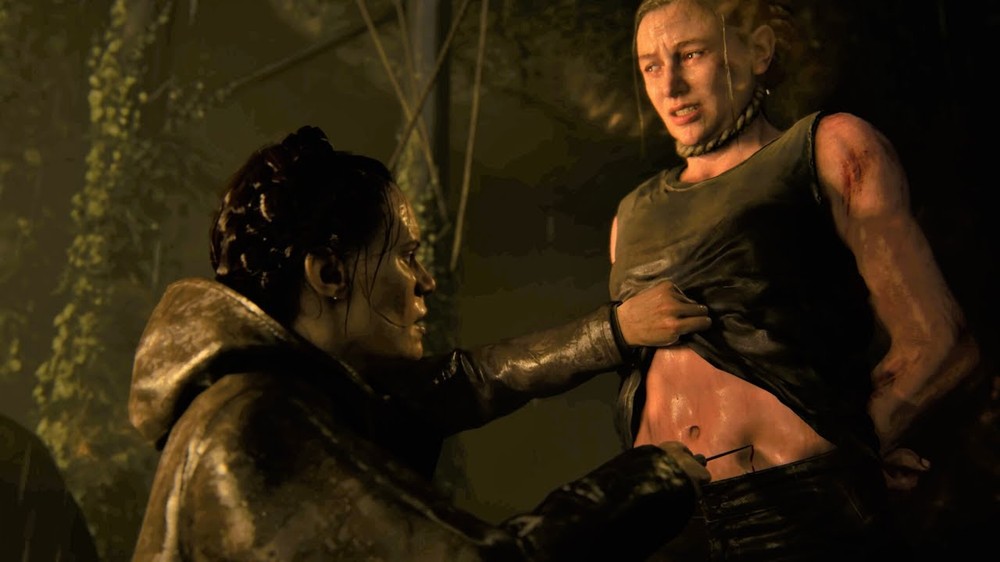 Character arcs were something else to be considered while playing. Joel’s arc was complete when he made his decision to sacrifice mankind for Ellie. I always had a hint that Ellie didn’t believe Joel’s denial at the end of the first game, which prompted her return visit to the hospital via the flashback and ultimate confrontation with Joel that drove a wedge in their relationship. Ellie had very little arc or personal development in The Last of Us Part II. Her laser-focused mission of revenge seldom wavered to the point where she was totally prepared to sacrifice her “happily ever after” for revenge.
Character arcs were something else to be considered while playing. Joel’s arc was complete when he made his decision to sacrifice mankind for Ellie. I always had a hint that Ellie didn’t believe Joel’s denial at the end of the first game, which prompted her return visit to the hospital via the flashback and ultimate confrontation with Joel that drove a wedge in their relationship. Ellie had very little arc or personal development in The Last of Us Part II. Her laser-focused mission of revenge seldom wavered to the point where she was totally prepared to sacrifice her “happily ever after” for revenge.
Abby had the most profound character arc, at least when viewed in hindsight. Her brutal attack on Joel seemed shocking only because we didn’t know who she was or her motivation at the time – the very same motivation that drove Ellie to her actions. But when you look at Abby’s story as pieced together from flashbacks as well as real-time gameplay moments you see a slowly evolving character in search of her own peaceful existence and possible return to the Fireflies. She was clearly unhappy with what the Wolves were doing and she clearly showed empathy for the outcast Scars who saved her. The whole situation with Lilly/Lev and his transgender choice seemed more rooted in a Mulan situation where, as a girl she was going to be forcibly married off to some warlord, when in reality all she wanted to do was become a soldier, thus the shaved head and perceived gender swap. Dina also had an emotional arc and outcome that I can totally agree with. When Ellie chose revenge over family Dina was well within her rights to walk away just as Ellie had done. The main takeaway from all of these arcs was that revenge is an endless cycle only finished by forgiveness. Abby shows this first when she lets Dina and Ellie live, and Ellie finally came around several gameplay hours and one lost relationship later.
 From a technical perspective The Last of Us Part II is clearly one of the best games ever made, making the most of what the PS4 can produce and certainly making me excited to see how much better the remastered version will be on the PS5. Everything from the level and character designs to the mo-capped performances, facial expressions, and even the smallest animation details are near-perfection. The camera work, lighting, shadows, weather effects, physics modeling, and the HDR lighting combined to create a cinematic masterpiece. Add to that an impressive score that either fit with or manufactured the desired emotions plus some of the best voice acting in video game history; The Last of Us Part II is an unforgettable experience and a critical piece of gaming culture.
From a technical perspective The Last of Us Part II is clearly one of the best games ever made, making the most of what the PS4 can produce and certainly making me excited to see how much better the remastered version will be on the PS5. Everything from the level and character designs to the mo-capped performances, facial expressions, and even the smallest animation details are near-perfection. The camera work, lighting, shadows, weather effects, physics modeling, and the HDR lighting combined to create a cinematic masterpiece. Add to that an impressive score that either fit with or manufactured the desired emotions plus some of the best voice acting in video game history; The Last of Us Part II is an unforgettable experience and a critical piece of gaming culture.
I think a lot of the hate for this game is simply because things didn’t turn out the way a lot of people had expected or hoped, but much like all entertainment, this is being created by a team that is telling the story they want to tell, which isn’t necessarily the story you want to hear. I went into this game with no personal feelings or investment in the characters, knowing full well that all key moments of decision were made for me in the first game and would likely be out of my control in the sequel. I was here for the ride and The Last of Us Part II delivered just that; a rollercoaster of narrative emotion, great character development, and intense adventure action. Will you play it more than once…probably not, but it’s certainly worth experiencing for yourself at least once; if not this generation then the next.
Sony chose not to provide us with a review copy of this game, so this review is based on a privately purchased copy of the game. We are under no influence or obligation to Sony or Naughty Dog.

